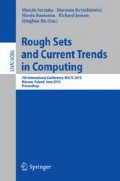Abstract
The paper presents how rule-based processing can be applied to automatically evaluate the motor state of Parkinson’s Disease patients. Automatic monitoring of patients by using biometric sensors can provide assessment of the Parkinson’s Disease symptoms. All data on PD patients’ state are compared to historical data stored in the database and then a rule-based decision is applied to assess the overall illness state. The training procedure based on doctors’ questionnaires is presented. These data constitute the input of several rule-based classifiers. It has been proved that the rough-set-based algorithm can be very suitable for automatic assessment of the PD patient’s stability/worsening state.
Access this chapter
Tax calculation will be finalised at checkout
Purchases are for personal use only
Preview
Unable to display preview. Download preview PDF.
References
Aminian, K., Najafi, B.: Capturing human motion using body-fixed sensors: outdoor measurement and clinical applications. Computer Animation and Virtual Worlds 15, 79–94 (2004)
Veltink, P.H., Bussmann, H.B.J., de Vries, W., Martens, W.L.J., van Lummel, R.C.: Detection of static and dynamic activities using uniaxial accelerometers. IEEE Trans. Rehab. Eng. 4(4), 375–386 (1996)
Wetzler, M., Borderies, J.R., Bigaignon, O., Guillo, P., Gosse, P.: Validation of a two-axis accelerometer for monitoring patient activity during blood pressure or ecg holter monitoring. Clinical and Pathological Studies (2003)
Mantyjarvi, J., Himberg, J., Seppanen, T.: Recognizing human motion with multiple acceleration sensors. IEEE International Conf. on Sys. Man and Cybernetics 2, 747–752 (2001)
Randell, C., Muller, H.: Context awareness by analysing accelerometer data. In: IEEE International Symposium on Wearable Comp., pp. 175–176 (2000)
Baga, D., Fotiadis, D.I., Konitsiotis, S., Maziewski, P., Greenlaw, R., Chaloglou, D., Arrendondo, M.T., Robledo, M.G., Pastor, M.A.: PERFORM: Personalised Disease Management for Chronic Neurodegenerative Diseases: The Parkinson’s Disease and Amyotrophic lateral Sclerosis Cases. In: eChallenges e-2009 Conference, Istanbul, Turkey, October 21-23 (2009)
The Unified Parkinson’s Disease Rating Scale (UPDRS): Status and Recommendations. State of the Art Review, Movement Disorders 18(7), 738–750 (2003)
Goetz, C.G., et al.: Movement Disorder Society-sponsored revision of the Unified Parkinson’s Disease Rating Scale (MDS-UPDRS): Process, format, and clinimetric testing plan. Movement Disorders 22(1), 41–47 (2007)
Maziewski, P., Kupryjanow, A., Kaszuba, K., Czyżewski, A.: Accelerometer Signal Pre-processing Influence on Human Activity Recognition. In: 13th IEEE NTAV/SPA Conference, Poznan, Poland, September 24-26, pp. 95–99 (2009)
Tsumoto, S.: Mining diagnostic rules from clinical databases using rough sets and medical diagnostic model. Information Sciences: International J. 162(1), 65–80 (2004)
Ryutaro, I., Masayuki, N.: Knowledge Discovery from Medical Database with Multi-Strategy Approach. SIG-FAI J. 51, 31–36 (2003)
Leondes, C.T. (ed.): Knowledge-based systems. Academic Press, London (2000)
Rough Set Exploration System, Skowron A. – Project Supervisor, http://logic.mimuw.edu.pl/~rses/
Wong, S.K.M., Ziarko, W., Li Ye, R.: Comparison of rough-set and statistical methods in inductive learning. International J. Man-Machine Studies 24, 53–72 (1986)
Cohen, W.W.: Fast Effective Rule Induction. In: Machine Learning: Proceedings of the Twelfth International Conference (1996)
Brenth, M.: Instance-Based Learning Nearest Neighbour with Generalization. Working Paper Series (1995)
Sokolova, M., Marchand, M., Japkowicz, N., Shawe-Taylor, J.: The Decision List Machine. University of Ottawa, Canada, University of London Egham, UK (2002)
Compton, P., Edwards, G., Kang, B., Lazarus, L., Malor, R., Menzies, T., Preston, P., Srinivasan, A., Sammut, S.: Ripple down rules: possibilities and limitations. University of New South Wales, PO Box 1, Kensington NSW, Australia 2033, Department of Chemical Pathology, St. Vincent’s Hospital Darlinghurst NSW, Australia (2010)
Richards, D., Compton, P.: Combining Formal Concept Analysis and Ripple Down Rules to Support the Reuse of Knowledge. School of Computer Science and Engineering, Sydney, Australia (1997)
Żwan, P., Szczuko, P., Kostek, B., Czyżewski, A.: Automatic Singing Voice Recognition Employing Neural Networks and Rough Sets. In: Peters, J.F., Skowron, A., Rybiński, H. (eds.) Transactions on Rough Sets IX. LNCS, vol. 5390, pp. 455–473. Springer, Heidelberg (2008)
Cyran, K.A., Mrozek, A.: Rough sets in hybrid methods for pattern recognition. International J. of Intelligent Systems 16(1), 149–168 (2001)
Wasserman, P.D.: Neural computing theory and practice. Van Nostrand Reinhold Co., New York (1989)
Weka Tool, http://www.cs.waikato.ac.nz/ml/weka/
Author information
Authors and Affiliations
Editor information
Editors and Affiliations
Rights and permissions
Copyright information
© 2010 Springer-Verlag Berlin Heidelberg
About this paper
Cite this paper
Żwan, P., Kaszuba, K., Kostek, B. (2010). Monitoring Parkinson’s Disease Patients Employing Biometric Sensors and Rule-Based Data Processing. In: Szczuka, M., Kryszkiewicz, M., Ramanna, S., Jensen, R., Hu, Q. (eds) Rough Sets and Current Trends in Computing. RSCTC 2010. Lecture Notes in Computer Science(), vol 6086. Springer, Berlin, Heidelberg. https://doi.org/10.1007/978-3-642-13529-3_13
Download citation
DOI: https://doi.org/10.1007/978-3-642-13529-3_13
Publisher Name: Springer, Berlin, Heidelberg
Print ISBN: 978-3-642-13528-6
Online ISBN: 978-3-642-13529-3
eBook Packages: Computer ScienceComputer Science (R0)

